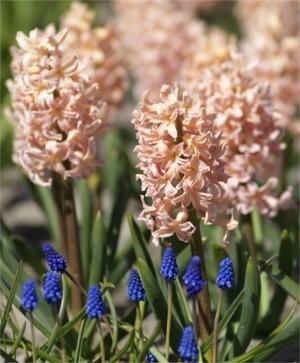 There are few flowers more iconic or glorious than Hyacinths in the spring. Hyacinths are the art, soul and fragrance of spring. They are known to be deer- and rodent-resistant and much loved by happily bumbling bees and helpful pollinators.
There are few flowers more iconic or glorious than Hyacinths in the spring. Hyacinths are the art, soul and fragrance of spring. They are known to be deer- and rodent-resistant and much loved by happily bumbling bees and helpful pollinators.
 The original species, Hyacinthus orientalis, was found in the wild of the eastern Mediterranean around 1562. The sweet perfume and colorful rainbow of H. orientalis varieties have filled the finest of gardens since 1850 or so when the Dutch began extensive hybridization. H. orientalis varieties yield plump, rigid racemes densely compacted with slightly reflexed, tubular florets, also known as nails, and three to four, upright strappy leaves. While hybrids with single florets or nails are the most prolifically grown, there are semi-double and double forms of Hyacinthus orientalis, such as H. orientalis Royal Navy. If you have ever seen photos of the April Blomencorso, Flower Bulb Parade, in the Haarlem to Noordwijk area of the Netherlands, you may be interested to know that most of the floats and intricate mosiacs displayed are constructed using Hyacinth flower petals.
The original species, Hyacinthus orientalis, was found in the wild of the eastern Mediterranean around 1562. The sweet perfume and colorful rainbow of H. orientalis varieties have filled the finest of gardens since 1850 or so when the Dutch began extensive hybridization. H. orientalis varieties yield plump, rigid racemes densely compacted with slightly reflexed, tubular florets, also known as nails, and three to four, upright strappy leaves. While hybrids with single florets or nails are the most prolifically grown, there are semi-double and double forms of Hyacinthus orientalis, such as H. orientalis Royal Navy. If you have ever seen photos of the April Blomencorso, Flower Bulb Parade, in the Haarlem to Noordwijk area of the Netherlands, you may be interested to know that most of the floats and intricate mosiacs displayed are constructed using Hyacinth flower petals.
 For well over a century, Dutch Hyacinths have not only been the rage in display gardens, they have also been the object of obsession as flowers forced in glass vases. These were not always simple glass vases that supported the bulb over water either. Hyacinth vases were also exquisite blown-glass vessels that were colored, etched, enameled and intricately adorned to enhance the extraordinary beauty of forced Hyacinths, particularly in Victorian era stately homes from the mid 1830s through the 20th century. If you'd like to find out more about the history and allure of Hyacinth glasses, The Curious History of the Bulb Vase by Patricia Coccoris (ISBN #978-0956809612) is a wonderful book. You can order it at www.hyacinthbulbvases.com).
For well over a century, Dutch Hyacinths have not only been the rage in display gardens, they have also been the object of obsession as flowers forced in glass vases. These were not always simple glass vases that supported the bulb over water either. Hyacinth vases were also exquisite blown-glass vessels that were colored, etched, enameled and intricately adorned to enhance the extraordinary beauty of forced Hyacinths, particularly in Victorian era stately homes from the mid 1830s through the 20th century. If you'd like to find out more about the history and allure of Hyacinth glasses, The Curious History of the Bulb Vase by Patricia Coccoris (ISBN #978-0956809612) is a wonderful book. You can order it at www.hyacinthbulbvases.com).
 Heirloom Hyacinths
Heirloom Hyacinths
If you are looking for heirloom flower bulbs, consider some of these beautiful and wonderfully fragrant varieties.
1893 H. orientalis City of Haarlem (included in the 1929 edition of John Scheepers Beauty from Bulbs)
1944 H. orientalis Delft Blue
1927 H. orientalis Gypsy Queen
1910 H. orientalis Jan Bos
1922 H. orientalis Pink Pearl
1954 H. orientalis White Pearl
1922 H. orientalis Woodstock
 Horticultural Zone Hardiness
Horticultural Zone Hardiness
Hyacinthus orientalis are good from horticultural zones 4 through 8. If your garden is in a horticultural zone that is either too cold or only marginally appropriate, you may want to apply no more than a 2" layer of mulch after the ground surface freezes in the fall. The mulch should trap the cool temperatures into the soil, not warmth. Mulch helps to protect the bulbs from arctic temperature spikes. Good mulching mediums include straw, salt marsh hay or oak leaves. In the spring, you can loosen the mulch in the area in which the Hyacinths will be sprouting.
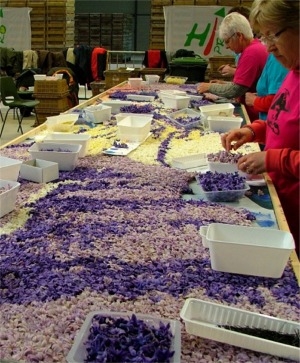 Bulb Inspection
Bulb Inspection
The first thing to mention is that some people develop an itchy reaction to touching Hyacinth bulbs. If you ever have had such an irritation, or if you don’t know how you will respond to touching Hyacinth bulbs, it is best to wear protective garden gloves. Take care not to touch your face or rub your eyes with your gloved hands. There is nothing to worry about if you do have an itchy reaction as annoying as it may be. Just wash the affected area with soap and water. It’s best to not include your children in planting Hyacinth bulbs, just in case.
Check your shipment against the packing slip and make sure that everything is as it should be. Occasionally, bags of smaller bulbs may be placed in the inner boxes of other bulbs to reduce jostling during shipment. If you can’t find something, open all of the inner boxes. If there is a discrepancy, please call us immediately so that we may resolve it with you. Since every bag or box of bulbs in your order has been scanned using its UPC barcode, we can usually tell you in which box each variety is located.
Inspect your bulbs carefully. We make every effort to ship you only healthy, firm, top quality bulbs.
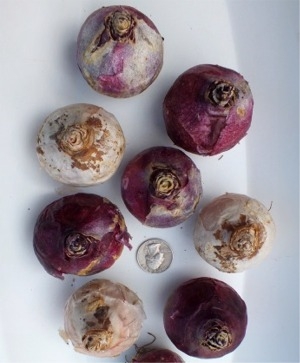 Hyacinth bulbs look different from other types of flower bulbs like Tulips or Narcissi. It is unique to Hyacinths that individual varieties may wear bulb tunics or sheaths of different colors. As examples, H. orientalis City of Haarlem is kind of a beige color, H. orientalis Gypsy Queen has a pale purple and silver bulb tunic and H. orientalis Pink Pearl has a rather deep purple-colored tunic.
Hyacinth bulbs look different from other types of flower bulbs like Tulips or Narcissi. It is unique to Hyacinths that individual varieties may wear bulb tunics or sheaths of different colors. As examples, H. orientalis City of Haarlem is kind of a beige color, H. orientalis Gypsy Queen has a pale purple and silver bulb tunic and H. orientalis Pink Pearl has a rather deep purple-colored tunic.
It is natural for some types of bulbs to develop a transportation mold when they are exposed to oxygen. It is a natural gray-blue-green mold that occurs when they are exposed to air, and that disappears as soon as the bulbs are planted. The soil naturally wicks it away. If you prefer, you may spread the bulbs out in the sun, or brush it off with a paper towel, although it is not necessary.
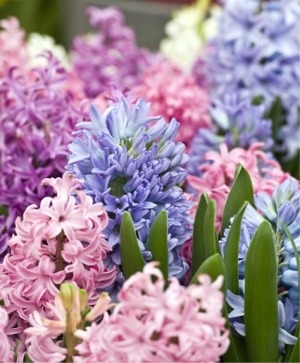 Little cuts, scars, discolored exteriors and dimples are normal marks from the flower bulb harvesting, cleaning and sizing processes in the Netherlands. Some bulbs may have a fully intact, papery skin or tunic, while others have partial skins, and others may be skinless. The existence or condition of the skin has nothing to do with the performance of the bulb. The most important factor is the way that the bulb feels. As long as the bulb is firm, it is a good and viable bulb. Some bulbs may already have tiny baby bulbs developing on the basal plate (root base) of the bulb while others may even have a little top shoot. Some bulbs may have old hairy roots on the basal plate, while others have none. Some bulbs are prettier than others, but you can rest assured that all of the flowers will be gorgeous!
Little cuts, scars, discolored exteriors and dimples are normal marks from the flower bulb harvesting, cleaning and sizing processes in the Netherlands. Some bulbs may have a fully intact, papery skin or tunic, while others have partial skins, and others may be skinless. The existence or condition of the skin has nothing to do with the performance of the bulb. The most important factor is the way that the bulb feels. As long as the bulb is firm, it is a good and viable bulb. Some bulbs may already have tiny baby bulbs developing on the basal plate (root base) of the bulb while others may even have a little top shoot. Some bulbs may have old hairy roots on the basal plate, while others have none. Some bulbs are prettier than others, but you can rest assured that all of the flowers will be gorgeous!
Hyacinth bulbs can exude a smelly viscous substance unfortunately called snot in Dutch. This can be wiped off with a paper towel. However, if you find a Hyacinth bulb with a discolored spot that is soft and you can push your finger into it, please call us. This rarely happens, but if it does, let us know and we will take care of it. That is not a good thing.
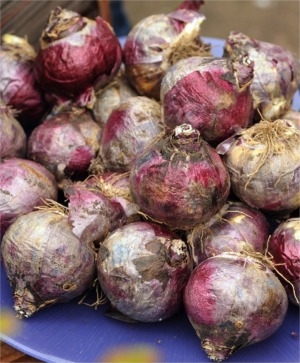 Bulb Size
Bulb Size
We offer Hyacinths in three different sizes. Our Hyacinth Bedding Mixture comes in a size 15/16 centimeters. Individual varieties are available in size 16/17 centimeters. Our Hyacinth Forcing and Exhibition Collection comes in the exhibition-size of 18/19 centimeters. The reason for the three different sizes has to do the possibility of staking Hyacinth flowering stems in the spring, and with offering a choice to those of us who force Hyacinths over the winter, particularly if a forced pot is to be entered into a juried garden show.
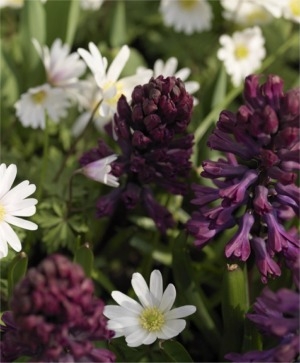 In general, Hyacinth orientalis yields large, thick and rigid, upright flowering spikes. The larger the bulb, the larger and heavier the flowering spike which may topple over, particularly after heavy spring rains or a heat spell. It is easy enough to prevent them from topping over: just slip a 12" tall green bamboo plant stake through the densely compacted nails into the soil beneath. Staking may be necessary for Hyacinth bulbs size 16/17 centimeters. Staking will be necessary for the 18/19 centimeter size. Our 15/16 centimeter Hyacinth Bedding Mixture will not require staking. That is a good thing since it is usually planted in large drifts or swaths.
In general, Hyacinth orientalis yields large, thick and rigid, upright flowering spikes. The larger the bulb, the larger and heavier the flowering spike which may topple over, particularly after heavy spring rains or a heat spell. It is easy enough to prevent them from topping over: just slip a 12" tall green bamboo plant stake through the densely compacted nails into the soil beneath. Staking may be necessary for Hyacinth bulbs size 16/17 centimeters. Staking will be necessary for the 18/19 centimeter size. Our 15/16 centimeter Hyacinth Bedding Mixture will not require staking. That is a good thing since it is usually planted in large drifts or swaths.
If you find that one bag of Hyacinth bulbs contains larger and smaller bulbs, it is a glass half full or half empty issue. Each of the bulbs is, at a minimum, the top size specified for that variety. They are sized on conveyor belts in the Netherlands that have holes the centimeter size just below the top size measurement. Smaller bulbs fall through these holes and are not included in our stock. All of the larger bulbs are included in our stock, and, as a result, there can be size variation. But it is definitely a glass half full! (If any variety in any season produces a smaller top size bulb than expected, we note it on our website. If a price change occurs as a result, we post the new price and make an adjustment on every order.)
 Bulb Storage Before Planting
Bulb Storage Before Planting
After you’ve received your order and inspected it, keep the exterior carton and the inner boxes open to give the bulbs some air. All bulbs love good air circulation. Store them in a cool, dry place with low humidity, away from heat, frost and strong sunlight at about 50°F to 70°F. Never put flower bulbs in the freezer! Poor storage conditions could cause bulbs to dry out, or to become moldy.
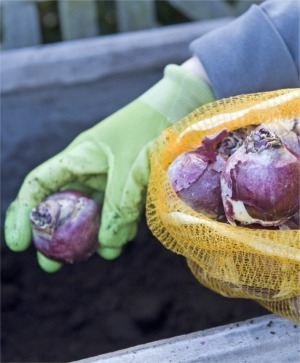 Select and Prepare the Planting Site
Select and Prepare the Planting Site
Don’t forget to wear protective garden gloves if you develop an itchy reaction to Hyacinth bulbs.
Hyacinth require rich, extremely well-draining and neutral pH soil. They hate to get wet feet: make sure to never plant them in an area that can become inundated with water after a heavy rain. The best soil is a sandy loam. For clay soil, break up the clay about a foot deeper than the planting depth of your bulbs and amend the bed with sand, peat moss and/or well-aged, neutral pH compost. For excessively sandy soil, amend the bed with peat moss, aged leaf compost and/or well-aged, neutral pH compost.
Please do not ever add horse manure, chicken droppings, mushroom compost, other hot manure or immature compost to your flower bulb beds. If you would like to add compost you’ve made yourself, please make sure that it is completely decomposed, healthy and neutral pH. Partially decomposed compost can spread fungal disease, such as botrytis blight, and nasty pests. What is good for vegetables is not necessarily good for flower bulbs.
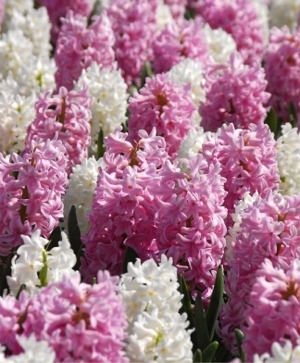 Think about planting fragrant Hyacinths in high traffic spots so their sweetness may be savored. Consider mixing two or more varieties together for a signature blend, or planting individual clusters throughout perennial beds like a recurrent melody. You may even want to consider planting them in a long winding ribbon, perhaps a two-tone ribbon, as the Keukenhof does in annual displays that take one's breathe away.
Think about planting fragrant Hyacinths in high traffic spots so their sweetness may be savored. Consider mixing two or more varieties together for a signature blend, or planting individual clusters throughout perennial beds like a recurrent melody. You may even want to consider planting them in a long winding ribbon, perhaps a two-tone ribbon, as the Keukenhof does in annual displays that take one's breathe away.
Hyacinth require full sunlight (a minimum of six hours per day) and prefer a dry period over the summer.
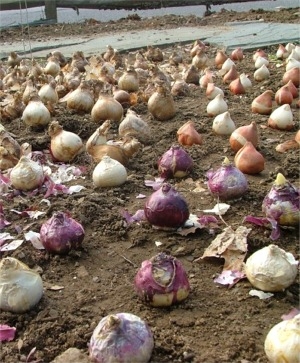 Easy to Plant
Easy to Plant
Hyacinth bulbs are so easy to plant and are really low maintenance. We'll ship you the bulbs in time for planting in your garden in the fall, once the ground has chilled down to about 55°F, after about two weeks of sweater weather when night time temperatures have hovered in the 40s. This is the best time to plant Hyacinth bulbs.
Flower bulbs do everything in response to temperature and sunlight. If bulbs are planted too early, before the ground has chilled down to around 55°F, they may grow unnecessary top growth, which could diminish their vitality in spring. If they are planted too late, all-important root system growth could be hampered. Immature, underdeveloped root systems could result in more foliage than flowers. Not good.
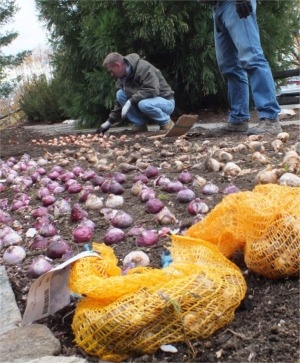 Plant Hyacinth bulbs 6" deep and 6" apart. Please do not put anything in the bottom of hole that you’ve dug for the bulbs. Even if you think it is good for the bulb, it could cause root burn. Nestle the bulb into its hole, fill in the hole with soil to the level of the bed, and tamp down the soil lightly, making sure that individual holes are no longer apparent and that the garden bed surface is level. This will help to prevent water from filling up any of the individual planting holes. All flower bulbs hate to get wet feet, particularly Hyacinth.
Plant Hyacinth bulbs 6" deep and 6" apart. Please do not put anything in the bottom of hole that you’ve dug for the bulbs. Even if you think it is good for the bulb, it could cause root burn. Nestle the bulb into its hole, fill in the hole with soil to the level of the bed, and tamp down the soil lightly, making sure that individual holes are no longer apparent and that the garden bed surface is level. This will help to prevent water from filling up any of the individual planting holes. All flower bulbs hate to get wet feet, particularly Hyacinth.
Both Hyacinthus orientalis and Multi-Flowering Festival Hyacinths are terrific cut flowers. They are also excellant bulbs for forcing over the winter in either soil or water. Please refer to our Hyacinth Forcing Tips for additional information.
 Fertilizing
Fertilizing
Never put anything, including fertilizer, in the bottom of each bulb planting hole. To do so is to run the risk of root burn. Plant the bulbs to the proper depth and spacing, tamp down the soil and broadcast a 5-10-5 or 4-10-6 granular organic fertilizer over the surface of the bed as if you were feeding the birds.
While all flower bulbs are nature’s perfect little packages and will bloom beautifully the first year, we recommend broadcasting fertilizer three times a year for all perennial and naturalizing flower bulbs. First at the time of fall planting to help grow the roots, second when the sprouts emerge in the spring to help nourish the foliage and flower, and finally, when the flowers start to die back to help feed the bulb itself. Bone meal is incomplete nutritionally and can attract animals to some varieties of bulbs.
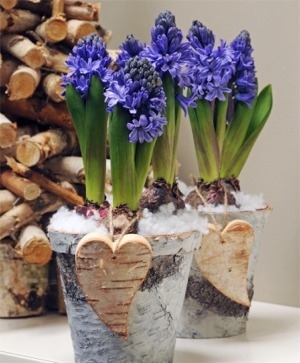 Hyacinth bulbs bloom the most perfectly with the largest flowering racemes the first spring. In following years, the flowering racemes will become less densely compacted, and smaller.
Hyacinth bulbs bloom the most perfectly with the largest flowering racemes the first spring. In following years, the flowering racemes will become less densely compacted, and smaller.
Do Not Plant Hyacinth in Exterior Containers or Raised Beds
Flower bulbs should never be planted in outdoor containers, window boxes or raised beds where bulbs experience temperature spiking and repeated cycles of freezing and thawing. This results in root growth failure, root system destruction, frozen bulbs and/or bulb rot from poor water drainage. Flower bulbs must have a consistent cold winter temperature with good water drainage in order to produce a mature root system that will permit foliage growth and flower production in the spring. If you are interested in having pots of blooming Hyacinths in your home over the winter, please refer to our Hyacinth Forcing Tips. You'll have to pot them in soil, or place them in a Hyacinth glass with water, and chill them in a dark, consistent temperature of 35°F to 45°F for ten to twelve weeks before bringing them in to your home to flower in about four weeks.
 Bloom Times, Size and Color
Bloom Times, Size and Color
The bloom time listed for Hyacinth is for horticultural zone 5 in normal spring conditions. The warmer the horticultural zone, the earlier flower bulbs will bloom. The colder the horticultural zone, the later flower bulbs will bloom in the spring.
Flower bulbs do everything in response to temperature, sunlight and site conditions. Bloom times, heights and colors are approximations affected by temperature and site conditions regardless of the calendar date. If it is a warm spring, bulbs will bloom earlier. If it is a cold spring, bulbs will bloom later. If it is a long cool spring, followed by rapid warming, you may find odd bedfellows: earlier blooming Galanthus flowering right along side later blooming Crocus, Species Tulips and Narcissi. Each spring can offer a different sort of garden surprise party.
In the event of a mild winter or a warmer-than-usual spring, flower bulbs that have emergent stalks with set buds may bloom early, small and short, although they will likely grow taller and larger as temperatures moderate. Temperature spikes can also affect mature root development, the actual form of the flower or the process of flower color maturation.
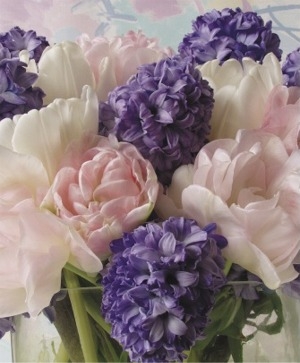 Spring Care
Spring Care
Once Hyacinth bloom and start to die back, make sure to keep the foliage going until it dies back naturally. A maximum period of photosynthesis allows the bulbs to regenerate for the future. Once the foliage is completely yellowed or browned out, remove it from the garden.
Don’t forget that Hyacinth are amazingly wonderful cut flowers by themselves or in combination with other spring flowering bulbs. To have the fragrance of Hyacinths in one’s home is not at all unlike finding buried treasure in your garden. You did.
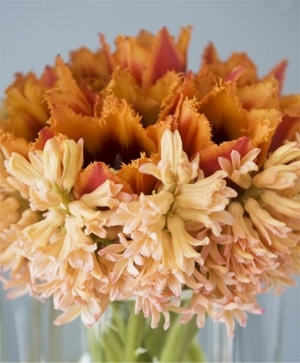 Trouble Shooting
Trouble Shooting
If Hyacinth are yielding more foliage than flowers, it normally indicates a root system issue, particularly the first spring. Hyacinth bulbs bloom the most perfectly with the largest flowering racemes the first spring. In following years, the flowering racemes will become less densely compacted, and smaller. It is a more informal natural look since the flowering racemes are usually not as uniformly shaped or rigid. Many dig up and discard, and plant fresh Hyacinth bulbs every couple of years.




